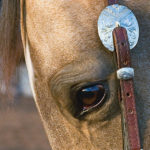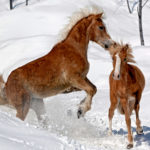With 36 to 44 chances for a toothache, equine dental care isn?t just a should-do but a yearly must-do ? and picking the right dentist for your horses is a delicate matter not to be taken lightly. As your mother (or father) used to say, ?an ounce of prevention is worth a pound of cure.?

A horse’s teeth literally begin to erupt in the first few days of life, and a horse should be seen for problems at any age, as young as 6 months old. Horses? teeth are called hypsodont teeth (having high or deep crowns and short roots, as in the molar teeth of a horse) that continue to erupt throughout a horse’s lifetime until the teeth are worn down to nothing. Taking care of a geriatric horse is a challenge unto itself, involving mashes, supplements and vigilance.
The goal of equine dentistry isn?t much different from human dentistry: perfecting what nature gave the horse, from crooked teeth to dental decay. Wild horses forage 16 to 18 hours a day under normal conditions, which allows their teeth to grind together and wear down the front teeth evenly, as well as the molars.
Because we often stall and feed horses, changing their natural grazing habits, their teeth often don’t wear the same, creating sharp points that can create problems. The front teeth can also wear unevenly, which can inhibit the proper intake and digestion of their food.
As horse owners, it’s part of our responsibility to see that our horses? needs are met, and the most important aspect of equine dentistry is prevention. Tooth loss in a horse is permanent. With regular check-ups, an equine dentist can find and correct other dental issues that can crop up as well, such as abscesses, ulcers, missing teeth, loose teeth, infected teeth or gums, periodontal disease, misalignment and abnormally long teeth.
Performance Issues
Horses that pull on the bit, shake their heads while being ridden, duck at the barrel or just act like they?ve never been trained (when you know better) may be having dental issues.
The horse that has in the past traveled with wonderful collection might begin to avoid a proper headset, or refuse a jump that has never been refused before. Often, with symptoms like these, the rider will check the saddle, change the bit, work the horse harder or even see a veterinarian about lameness issues, but often, it is really as simple as a toothache (or cheek-ache).
Horses that show weight loss, drop food, show quidding (cigar-shaped wads of hay balls that the horses stuff in sore places of their mouths to eat in more comfort), buck, chew the bit, have bad breath, wring their tails, tilt their heads or drool are exhibiting symptoms of a horse that needs to see the dentist.
Dr. Penny Lloyd, D.V.M., has specific training in equine dentistry beyond her original veterinary schooling, and she keeps up on the newest advances in equine dentistry by attending the yearly American Association of Equine Practitioners convention.
Before Dr. Lloyd starts on the dental work for two Quarter Horses, one 11 and one pushing 20, she checks their hearts, feels their faces for any bumps, swelling or signs of pain, and then she injects the first horse with just enough sedation to work, on the theory that a sedated horse is a happy horse that will not equate teeth floating with the end of the world, as well as making her job as an equine dentist that much easier.
?The horse doesn’t throw its head around and get hurt, the people on the ground don’t get hurt, and the horse does not fear me the next time I come to work on his teeth,? Dr. Lloyd says.
Using a full-mouth speculum, Dr. Lloyd starts her exam by feeling the inside of the mouth, front to back, and then looking farther inside with her light.
?(In the late 1980s), when I started, I learned by feel,? Dr. Lloyd says. ?You?d hold a horse’s head up, pull their tongue to the side and use a flashlight, feeling about for loose teeth with a mirror and a pick. And while that worked at the time, I have since become a firm believer in the usefulness of the full-mouth speculum.?
After washing the horse’s mouth out with water, Dr. Lloyd grabs a specialized power drill with a sanding bit on the end of it and evens out the waves, points and misshapen teeth in the horse’s mouth. Seeker Sonny, 11, has an ulcer on his cheeks from sharp molar points and a wolf tooth that needs to be removed. While she is in there, Dr. Lloyd adds a bit seat to both sides of his mouth, which makes it more comfortable for the horse to hold a bit without getting any skin between the bit and the tooth.
While working on 20-year-old ?Cowboy,? Dr. Lloyd grabs her hand floater and places it on the side of his head to show just how far back she could reach with it. She cautions that Cowboy?s teeth are more sensitive due to his age, making it harder for him to chew foods like senior feed and cookie treats, and she recommends that his food be soaked in water before feeding.
After floating the teeth to a comfortable length, Dr. Lloyd grabs each horse’s jaw to ?check the grind? by literally moving the top and the bottom of the jaw at the same time. As an accomplished equine chiropractor as well, Dr. Lloyd also checks the temporal mandible joint for any issues that might have arisen from using the full-mouth speculum.
The effects of the sedation are short-lived, and both horses are able to be transported safely about 20 minutes after Dr. Lloyd finished working on them. Dr. Lloyd cautions that the horses should not be allowed to eat until they got home (no hay bag in the trailer) and says she is available for follow-up calls or concerns.
Let?s Talk Cost
If there is anything inexpensive about owning horses, I haven’t found it yet. Equine dentistry is no exception. While costs vary from state to state, it’s a safe bet that you’ll spend at least $100 per horse if you are using a veterinarian who also is a dentist.
Sedation in this case was $25 a piece ? and Cowboy, being the tough old bird that he is, needed two rounds. The floating was $85 per horse, and the wolf tooth extraction was a part of the floating cost. I had Dr. Lloyd throw in a chiropractic session for the old guy for another $125. Add that to $3+ a gallon fuel, and it adds up. The plus side is that most horses only need to be seen by the dentist once a year.
Courtesy AQHA’s America’s Horse Daily.





